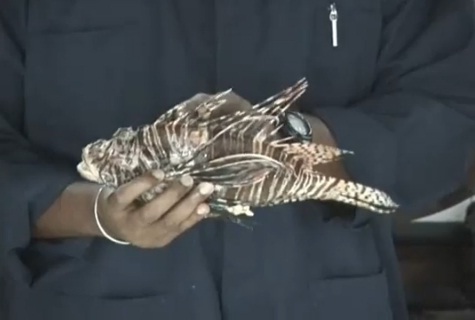The invasive lionfish (Pterois volitans/miles) has well-known negative effects on recruitment and abundance of native fish populations in the Caribbean (Albins 2012, Albins and Hixon 2008, Green et al. 2012, Johnston and Purkis 2011).
Potential native predators seem to largely avoid consuming lionfish independently and so Caribbean lionfish populations increased 13 to 15 fold relative to those in its native range (Darling et al. 2011, Kulbicki et al. 2011, Mumby et al. 2011).
Consequently, concerns exist about potential irreversible declines of Caribbean fish populations due to predation of the invasive lionfish. Control management strategies have been proposed and implemented Caribbean wide to reduce local lionfish populations.
Though strategies vary between islands depending on local laws, lionfish reduction efforts generally rely on local recreational divers using some form of underwaterspear or –harpoon. Whether such control efforts of lionfish populations are effective is currently unknown, though expected to be successful under certain circumstances based on predictive modelling of various removal programs (Barbour et al. 2011, Morris et al. 2011). We quantified the effectiveness of lionfish control management on the nearby islands Bonaire and Curaçao (Southern Caribbean).
The first official sighting of lionfish on both islands occurred in October 2009 and within 6 months it spread around the two islands. Active reduction efforts were immediately started on Bonaire by the marine park authority which trained > 300 local divers to use spearguns. While spearfishing is illegal on both islands, local authorities contracted local divers and provided them with small modified spearguns (‘ELF’s – Eradicate Lion Fish’) designed to kill only lionfish.
On Curaçao, a similar program was implemented by the local government 19 months later (July 2011) than on Bonaire which resulted in 70 trained volunteers. To assess whether eradication efforts on Bonaire lead to a successful reduction of the local lionfish population, we compared the abundance of lionfish on Bonaire (fished) and Curaçao (unfished) between June and August 2011, i.e. just before official removal efforts began on Curaçao. Lionfish abundance (in g/m2) was estimated at 23 locations on Bonaire and 14 locations on Curaçao in 50 x 4 meter belt transects at 15, 25 and 35 meters depth on the leeward side of both islands. Results showed that after two years of active lionfish removal on Bonaire compared to an unfished Curaçao, lionfish biomass on Bonaire was on average 4.2 times lower than on Curaçao (Figure 1A).
Secondly, lionfish weight and size on Curaçao were 33 and 15% higher than on Bonaire (Figure 1B+C). Therefore, effective control of invasive lionfish in areas that have an active diving community, is possible through involvement of this community in local management efforts.
See full report here: GCFI_64-16 – Lionfish Ramon (PDF)
